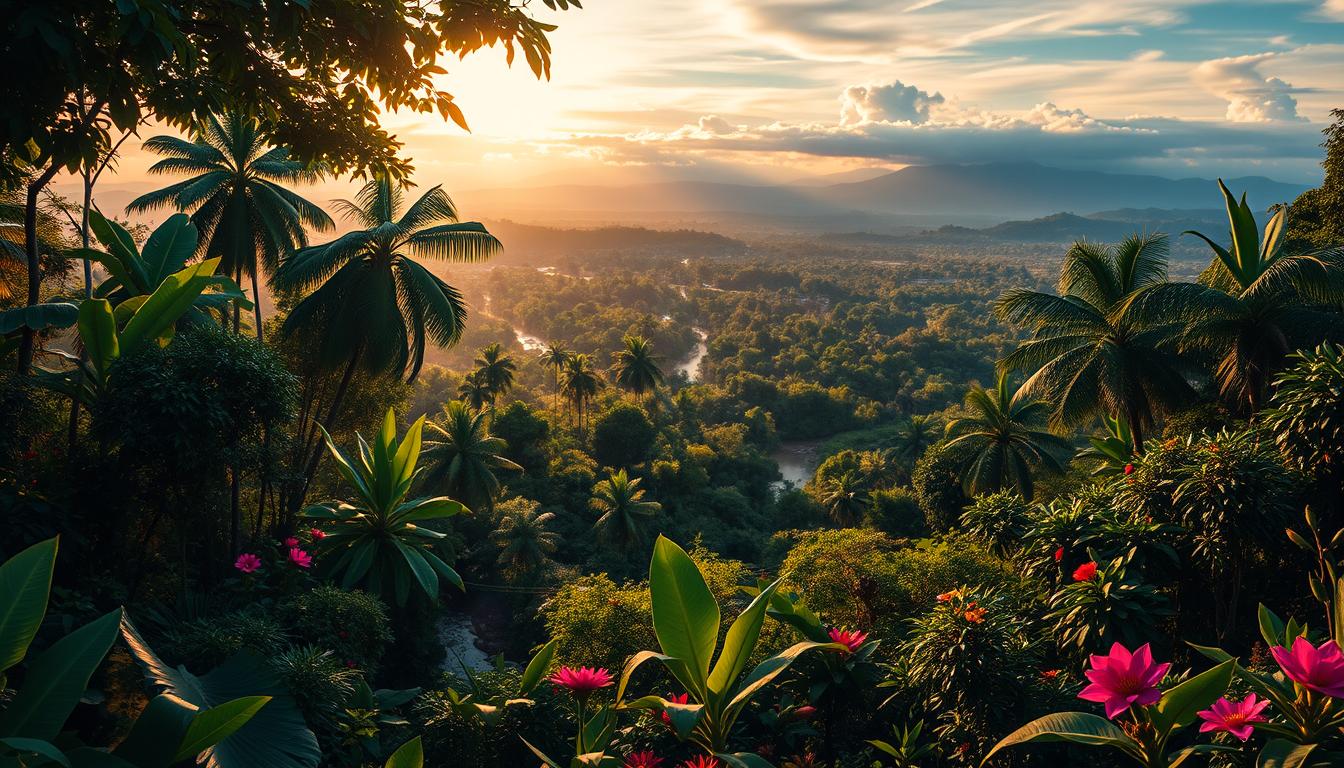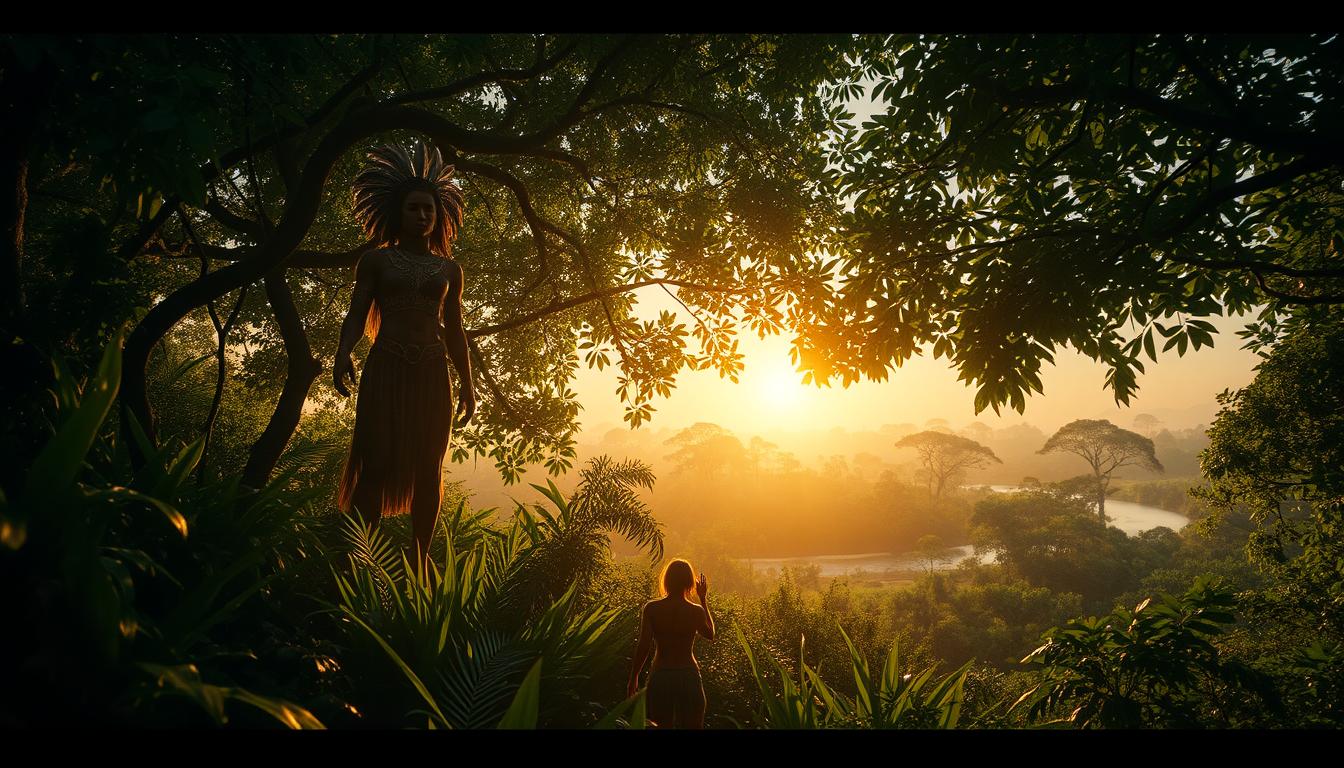The Amazon Rainforest is often referred to as the “lungs of the Earth,” producing about 20% of the world’s oxygen. This vast region of lush vegetation plays a vital role in maintaining global biodiversity and regulating the climate.
Imagine a place where the air is crisp, and the sounds of exotic birds and animals fill the atmosphere. This is the Amazon Rainforest, a treasure trove of natural wonders. Its health is crucial not just for the local wildlife but for the entire planet.
Key Takeaways
- The Amazon Rainforest is a vital component of the global ecosystem.
- It supports a vast array of biodiversity.
- The rainforest plays a significant role in climate regulation.
- Its health affects oxygen production and carbon dioxide absorption.
- Preserving the Amazon is crucial for the planet’s well-being.
The Critical Ecosystem of the Amazon Rainforest
The Amazon Rainforest is a complex and delicate ecosystem that provides numerous ecological functions and environmental services essential for the health of our planet. This vast rainforest spans across nine countries in South America, covering an area of over 5.5 million square kilometers.
Global Significance and Geographic Scale
The Amazon Rainforest is not only the largest tropical rainforest but also one of the most biodiverse regions on Earth. It plays a crucial role in global ecological balance, supporting a vast array of plant and animal species. The rainforest’s immense size and geographic scale make it a significant contributor to global climate regulation, producing about 20% of the world’s oxygen.

Ecological Functions and Environmental Services
The Amazon Rainforest provides numerous ecological functions, including carbon sequestration, water cycling, and habitat creation for countless species. These environmental services are vital for maintaining the health of our planet. The rainforest’s ability to absorb and store carbon dioxide makes it a crucial component in the fight against climate change. Additionally, the Amazon Rainforest supports local communities by providing them with food, shelter, and livelihoods.
The intricate balance within the Amazon Rainforest ecosystem is a testament to the natural world’s complexity and beauty. Understanding and preserving this ecosystem is essential for maintaining global biodiversity and ecological health.
Biodiversity Treasures of the Amazon
The Amazon Rainforest is a treasure trove of biodiversity, boasting an incredible array of flora and fauna. This rich biodiversity is a result of the Amazon’s unique geography and climate, which have created a complex ecosystem that supports a wide range of plant and animal life.
Flora Diversity: Plant Species and Unique Adaptations
The Amazon is home to over 40,000 plant species, many of which are found nowhere else on Earth. The rainforest’s flora includes giant water lilies, orchids, and towering trees like the kapok and Brazil nut. These plants have evolved unique adaptations to survive in the Amazon’s competitive environment.

Fauna Diversity: Iconic Wildlife and Endemic Species
The Amazon is renowned for its iconic wildlife, including jaguars, sloths, and macaws. The rainforest is also home to a vast array of endemic species that are found only in this region. Conservation efforts are crucial to protect these species and their habitats.
| Species | Type | Status |
|---|---|---|
| Jaguars | Mammal | Near Threatened |
| Poison Dart Frogs | Amphibian | Endangered |
| Macaws | Bird | Vulnerable |
Microbial Life and Undiscovered Species
Beneath the Amazon’s surface lies a vast world of microbial life, with countless species still waiting to be discovered. These microorganisms play a crucial role in the ecosystem, influencing everything from decomposition to the health of plants and animals.
Protecting the Amazon’s biodiversity is essential for maintaining the health of our planet. Efforts to conserve this ecosystem must include biodiversity protection strategies that address the complex interplay between species and their environments.
The Amazon’s Role in Global Climate Regulation
The Amazon Rainforest plays a vital part in maintaining the balance of the global climate. Its vast ecosystem contributes significantly to the regulation of climate patterns worldwide.
Carbon Storage and Oxygen Production
The Amazon Rainforest is a massive carbon sink, absorbing and storing carbon dioxide, a key greenhouse gas. This carbon storage capacity helps mitigate the effects of climate change. Additionally, the rainforest produces a substantial amount of oxygen through photosynthesis, contributing to the global oxygen supply.
Influence on Weather Patterns and Rainfall
The Amazon’s vast vegetation and water cycles significantly influence regional and global weather patterns. Through transpiration, plants release water vapor into the atmosphere, affecting rainfall both locally and globally.
Regional Climate Effects
The Amazon Rainforest drives regional climate regulation by creating rainfall and maintaining humidity levels. This has a direct impact on agriculture and water resources in the region.
Global Climate Connections
The Amazon’s influence extends beyond its regional boundaries, impacting global climate systems. Changes in the Amazon can have far-reaching consequences, affecting climate patterns worldwide.

Threats Facing the Amazon Ecosystem
The Amazon Rainforest, a vital component of the Earth’s ecosystem, is facing numerous threats that could have far-reaching consequences. The delicate balance of this ecosystem is being disrupted by various human activities and environmental changes.

Deforestation: Causes, Rates, and Consequences
Deforestation is one of the most significant threats to the Amazon Rainforest. The main causes include agricultural expansion, livestock grazing, and logging. The rate of deforestation has been alarming, with significant portions of the forest being cleared in recent years. The consequences are dire, including loss of biodiversity, soil erosion, and increased greenhouse gas emissions.
Climate Change Impacts on Forest Health
Climate change is another major threat to the Amazon ecosystem. Rising temperatures and changing precipitation patterns are altering the forest’s health and resilience. Droughts, in particular, have become more frequent and severe, leading to increased tree mortality and fire risk. This not only affects the forest but also contributes to climate change, creating a vicious cycle.
Mining, Agriculture, and Industrial Development
Mining, agriculture, and industrial development are also posing significant threats to the Amazon Rainforest. Mining activities lead to habitat destruction and pollution, while agricultural expansion results in widespread deforestation. Industrial development, including infrastructure projects like dams and roads, further fragments the forest and disrupts wildlife habitats.
Addressing these threats requires a concerted effort towards rainforest sustainability. This involves adopting sustainable land-use practices, protecting indigenous communities, and promoting conservation efforts. By working together, we can help preserve the Amazon Rainforest for future generations.
Indigenous Communities: Guardians of the Forest
The intricate relationship between indigenous communities and the Amazon Rainforest is a testament to sustainable living and biodiversity protection. For centuries, these communities have lived in harmony with the forest, developing traditional knowledge and practices that have allowed them to thrive without causing significant harm to the ecosystem.

Traditional Knowledge and Sustainable Practices
Indigenous communities possess a deep understanding of the Amazon’s ecology, allowing them to manage the forest sustainably. Their traditional practices include rotational farming, selective logging, and the use of forest products for medicine and food. These methods not only ensure the communities’ survival but also contribute to rainforest preservation.
Challenges and Rights of Indigenous Populations
Despite their crucial role in maintaining the Amazon’s balance, indigenous communities face numerous challenges, including deforestation, land encroachment, and climate change. It is essential to recognize and support their rights to their ancestral lands, enabling them to continue their sustainable practices and protect the forest from further degradation.
By supporting indigenous communities and their traditional knowledge, we can enhance biodiversity protection efforts and promote a more sustainable future for the Amazon Rainforest.
Conservation Efforts and Sustainable Solutions
In response to the growing threats, the Amazon Rainforest is witnessing a surge in conservation efforts and sustainable development initiatives. These efforts are crucial for preserving the Amazon’s vast ecosystem and ensuring its continued health and resilience.
Protected Areas and Conservation Reserves
One of the key strategies in conserving the Amazon Rainforest is the establishment of protected areas and conservation reserves. These areas provide a safe haven for the Amazon’s diverse flora and fauna, shielding them from deforestation and habitat destruction. As of now, a significant portion of the Amazon is under some form of protection, with efforts ongoing to expand these areas further.
International Cooperation and Policy Initiatives
International cooperation and policy initiatives play a vital role in Amazon conservation. Agreements between countries and international organizations help in coordinating efforts to protect the Amazon, sharing knowledge, and implementing policies that support sustainable forest management. Initiatives like the Amazon Fund are examples of global cooperation aimed at conserving the rainforest.
“The Amazon Rainforest is not just a local or national issue; it’s a global concern that requires international cooperation and commitment to conservation.”
Sustainable Development and Economic Alternatives
Sustainable development and economic alternatives are being explored to reduce the economic pressures driving deforestation. This includes promoting eco-tourism, sustainable agriculture, and forest products that are certified as sustainably sourced. By providing economic benefits to local communities through sustainable practices, these initiatives help in reducing the reliance on activities that harm the forest.

These conservation efforts and sustainable solutions offer hope for the future of the Amazon Rainforest. Continued support and expansion of these initiatives are crucial for the long-term preservation of this critical ecosystem.
Securing the Future of the Amazon Rainforest
The Amazon Rainforest’s critical ecosystem is a treasure that requires our collective care. As we’ve explored, its global significance, biodiversity, and role in climate regulation make it an irreplaceable asset for our planet.
Maintaining the health of the Amazon ecosystem is crucial for supporting indigenous communities, preserving ecological balance, and ensuring the well-being of our planet. Efforts to protect this vital ecosystem include establishing protected areas, promoting sustainable practices, and supporting conservation initiatives.
By working together to address the threats facing the Amazon, such as deforestation and climate change, we can help secure its future. The critical ecosystem of the Amazon rainforest is worth preserving, and its continued health is essential for the health of our planet.




